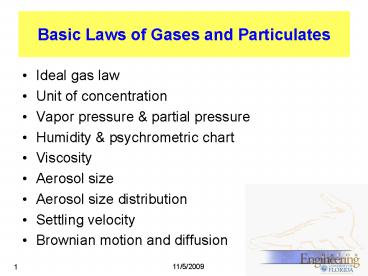Basic Laws of Gases and Particulates - PowerPoint PPT Presentation
1 / 19
Title:
Basic Laws of Gases and Particulates
Description:
What is the volume of 1 g-mole of air at 25 oC and 1 atm? How many lb-moles are there for 380 ft3 of air at 60 oF ... http://www.usatoday.com/weather/wsling.htm ... – PowerPoint PPT presentation
Number of Views:104
Avg rating:3.0/5.0
Title: Basic Laws of Gases and Particulates
1
Basic Laws of Gases and Particulates
- Ideal gas law
- Unit of concentration
- Vapor pressure partial pressure
- Humidity psychrometric chart
- Viscosity
- Aerosol size
- Aerosol size distribution
- Settling velocity
- Brownian motion and diffusion
2
Ideal Gas Law
P pressure V volume n mole R Ideal gas law
constant T Temperature M mass MW molecular
weight ? density Q volume flow rate molar
flow rate
Other references 1. CRC Handbook of Chemistry
Physics 2. Perrys Chemical Engineers Handbook
3
Ideal Gas Law Constant
What is the volume of 1 g-mole of air at 25 oC
and 1 atm? How many lb-moles are there for 380
ft3 of air at 60 oF and 14.7 psi?
Avogadros number 6.023?1023 molecules/mole At
1 atm and 25 oC, 1 mole of air has a volume of
24.5 L
4
Unit of Concentration
Section 7.1.2
5
Concentration on a dry basis
- Water vapor is commonly present in a heated gas
stream, e.g., combustion of a hydrocarbon fuel. - Water vapor can condense as temperature cools
down. The amount varies and is very sensitive to
temperature. - To prevent the variation, standards are written
to correct to "dry" conditions when expressing
concentrations.
6
Vapor Pressure
- The pressure required to maintain a vapor in
equilibrium with the condensed vapor (liquid or
solid) with a flat surface at a specified
temperature
7
(No Transcript)
8
What is the vapor pressure of water at 20 oC? If
the measurement is conducted on Mars (the
atmospheric pressure is about 0.006 atm), what
will be the value?
9
Partial Pressure
10
Humidity in Air/Water Mixture
- The state of an air/water mixture is determined
by pressure, temperature humidity
- Psychometric Chart (Figure 1.3)
- Dry bulb temperature
- Wet bulb temperature the temperature at which a
thermometer with a wet wick wrapped around the
bulb stabilizes
Why is TDB always higher than TWB?
http//www.usatoday.com/weather/wsling.htm
Properties of TDB of 40 oC and TWB of 30 oC?
11
http//howard.engr.siu.edu/staff1/tech/MET/ET401/L
AB/psychro_carrier_si.jpg
12
Viscosity
- A measure of frictional force between fluid
layers moving at different velocities
At 20 oC, the viscosity (?) of air is 1.81?10-5
Pas (Ns/m2). The temperature dependence (on
absolute temperature) is
(Valid between -70 to 500 oC)
What is the viscosity of air at 100 oC?
13
Characterizing an Aerosol Particle
How do we characterize a particle?
Coal fly ash particles
Iron oxide particles from arc welding
- Size, Shape, Density, Composition (toxicity,
corrosivity, reactivity), Phase (liquid, solid)
Why should we care the aerosol size?
14
Size Range of Aerosol Particles
Hinds, Aerosol Technology, 1999
15
Aerosol Size Distribution
How do we characterize particleS?
- Concentration
- Number concentration by counting
- Mass concentration by weight measurement
- Size
- Spread
- Particle size distribution
16
Type of Size Distribution
- Ex. A system containing spherical particles
- Number Concentration Mass
Concentration - 100 /cc 1?m ? 1.91g/cm3 10-10 g/cc 1?m
- 1 /cc 10?m
10-9 g/cc 10?m
Do we have more 1 ?m or 10 ?m particles (i.e.
are the majority 1 or 10 ?m)? How will it
impact the PSD we see?
Number Distribution
Number distribution function
17
Settling Velocity
In settling, an aerosol experiences gravitational
force (FG) and drag force (FD)
18
Brownian Motion Diffusion
http//galileo.phys.virginia.edu/classes/109N/more
_stuff/Applets/brownian/brownian.html
http//www.geocities.com/piratord/browni/Difus.htm
l
- The primary transport mechanism for small
particles (lt 0.1 ?m) Important when transport
distance is small e.g. filter, airway in human
lung - Brownian motion irregular wiggling motion of a
particle caused by random bombardment of gas
molecules against the particle - Diffusion the net transport of the particles
from a region of higher concentration to a region
of lower concentration
k 1.38X10-23 J/K or 1.38X10-16 erg/K
19
Quick Reflection

